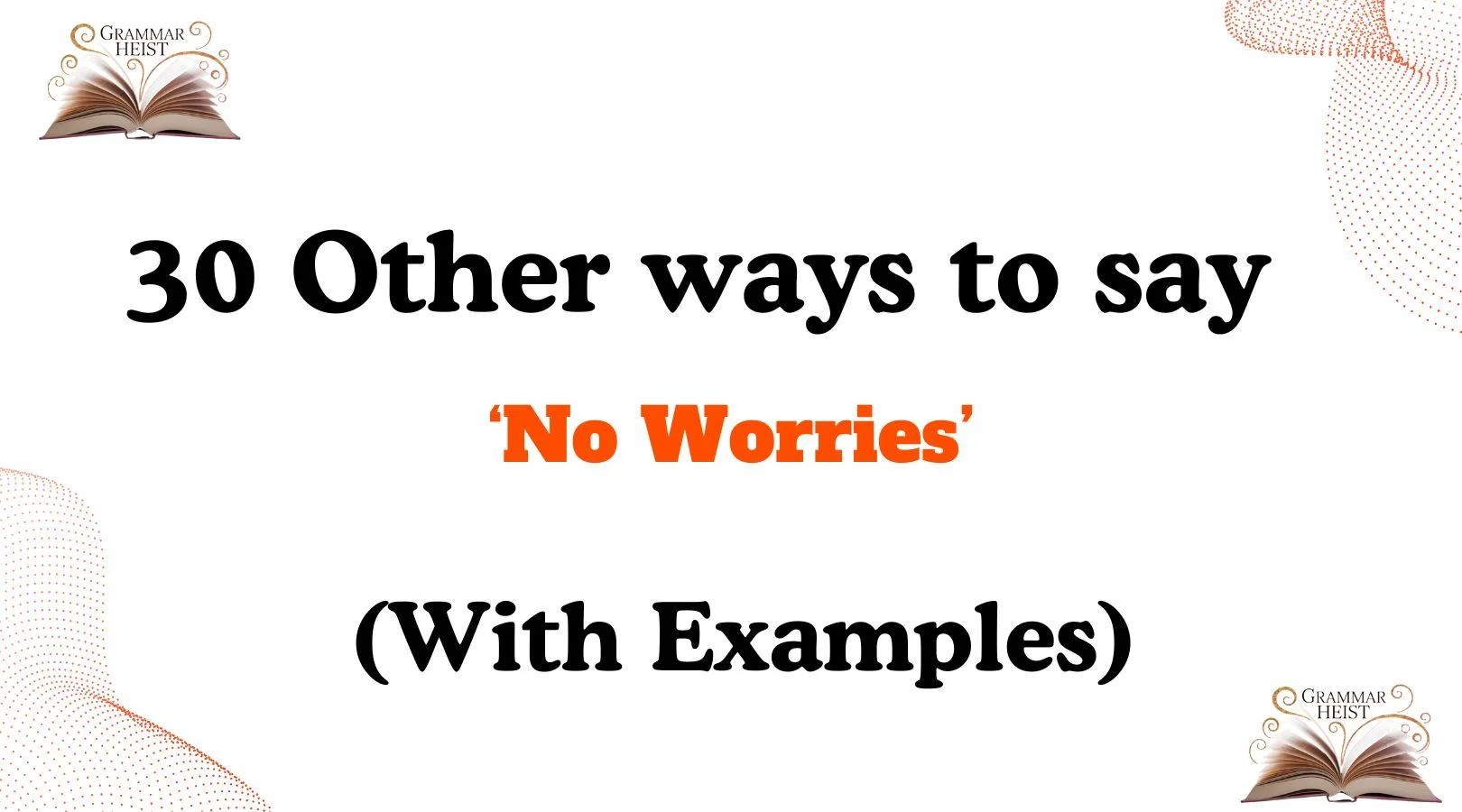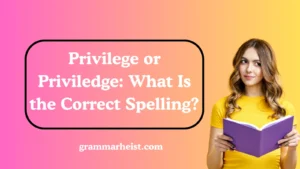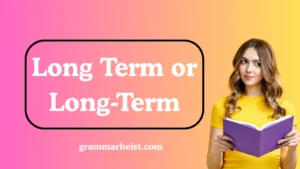Finding the right words to express understanding, reassurance, or empathy can make all the difference in communication. Saying “no worries” is casual and friendly, but sometimes we want something that feels more personal, thoughtful, or professional. This article explores 30 meaningful alternatives to say “no worries,” complete with scenarios, examples, tone, and explanations to help you communicate with warmth and care.
What Does “No Worries” Mean?
“No worries” is a casual phrase used to reassure someone that everything is fine, that there’s no problem, or that they shouldn’t feel guilty about something. It conveys relaxation, understanding, and support in informal contexts.
Is It Professional/Polite to Say “No Worries”?
While “no worries” is widely accepted in casual conversation, in formal or professional settings, it might be better to use alternatives like “you’re welcome” or “it’s not a problem” to maintain professionalism. Tone matters depending on the context and audience.
Pros and Cons
Pros:
- Friendly and approachable
- Quick to say
- Shows empathy
Cons:
- Too casual for formal or professional settings
- Can feel vague if overused
- May not convey strong reassurance in serious situations
Synonyms For “No Worries”
- No Problem
- Don’t Mention It
- It’s All Good
- You’re Welcome
- Happy to Help
- Not a Problem
- No Big Deal
- All Good
- Sure Thing
- Anytime
- Don’t Worry About It
- It’s Fine
- No Sweat
- Not at All
- Think Nothing of It
- It’s No Trouble
- Don’t Give It a Second Thought
- That’s Okay
- No Need to Apologize
- It’s Nothing
- You Got It
- Everything’s Fine
- That’s Alright
- No Hard Feelings
- Not an Issue
- Think Nothing About It
- No Trouble at All
- You Bet
- Glad to Help
- My Pleasure
1. No Problem
Scenario: Someone thanks you for helping them.
Examples:
- “Thanks for helping me with my homework!” – “No problem!”
- “I appreciate you picking this up for me.” – “No problem, happy to help.”
- “Thanks for covering my shift.” – “No problem at all.”
Tone: Casual, friendly, reassuring
Explanation: Simple and approachable; conveys that assistance was given gladly.
2. Don’t Mention It
Scenario: Someone apologizes or thanks you.
Examples:
- “Sorry for bothering you.” – “Don’t mention it.”
- “Thanks for lending me your notes.” – “Don’t mention it.”
- “I owe you one.” – “Don’t mention it.”
Tone: Polite, humble
Explanation: Downplays the effort, showing generosity and modesty.
3. It’s All Good
Scenario: A minor mistake occurs or someone expresses concern.
Examples:
- “I spilled coffee on your desk.” – “It’s all good.”
- “I was late to the meeting.” – “It’s all good, we can start now.”
- “I forgot to reply to your email.” – “It’s all good, I just saw it.”
Tone: Relaxed, casual
Explanation: Conveys calm reassurance, removing tension or guilt.
4. You’re Welcome
Scenario: Someone thanks you formally or professionally.
Examples:
- “Thank you for your help with the report.” – “You’re welcome.”
- “I really appreciate your advice.” – “You’re welcome.”
- “Thanks for picking up the files.” – “You’re welcome.”
Tone: Polite, professional
Explanation: Standard, respectful, and universally appropriate.
5. Happy to Help
Scenario: Offering assistance or responding to gratitude.
Examples:
- “Thanks for your guidance today.” – “Happy to help!”
- “I appreciate you fixing this issue.” – “Happy to help anytime.”
- “Thank you for your support.” – “Always happy to help.”
Tone: Warm, friendly, encouraging
Explanation: Expresses willingness and a positive attitude.
6. Not a Problem
Scenario: Someone apologizes for a small inconvenience.
Examples:
- “Sorry I’m late.” – “Not a problem.”
- “Thanks for covering me.” – “Not a problem at all.”
- “I accidentally deleted the file.” – “Not a problem, I have a backup.”
Tone: Casual, reassuring
Explanation: Conveys that the issue is minor and easily handled.
7. No Big Deal
Scenario: Someone worries about a minor mistake.
Examples:
- “I forgot your book.” – “No big deal.”
- “Sorry I made a typo in the email.” – “No big deal, I understood it.”
- “I didn’t make the deadline.” – “No big deal, we can adjust.”
Tone: Casual, empathetic
Explanation: Reduces stress, reassuring that the mistake is insignificant.
8. All Good
Scenario: General reassurance in casual conversation.
Examples:
- “I’m sorry for the delay.” – “All good.”
- “Thanks for helping me out last minute.” – “All good.”
- “I didn’t finish the project.” – “All good, we’ll manage.”
Tone: Relaxed, supportive
Explanation: Short and friendly; conveys ease and calm.
read More:30 Other Ways to Say ‘I Hope You Enjoyed’ (With Examples)
9. Sure Thing
Scenario: Responding to thanks or agreement requests.
Examples:
- “Thanks for picking up lunch.” – “Sure thing!”
- “Can you help me with this task?” – “Sure thing!”
- “I appreciate your guidance.” – “Sure thing, anytime.”
Tone: Friendly, confident
Explanation: Informal and enthusiastic acknowledgment.
10. Anytime
Scenario: Expressing willingness for repeated favors.
Examples:
- “Thanks for helping me move.” – “Anytime!”
- “I appreciate you mentoring me.” – “Anytime, happy to help.”
- “Thanks for answering my questions.” – “Anytime, don’t hesitate.”
Tone: Friendly, open, welcoming
Explanation: Suggests availability and a generous spirit.
11. Don’t Worry About It
Scenario: Someone feels guilty or apologizes.
Examples:
- “Sorry I didn’t call back.” – “Don’t worry about it.”
- “I messed up the schedule.” – “Don’t worry about it, we can fix it.”
- “I forgot to reply.” – “Don’t worry about it, it happens.”
Tone: Reassuring, empathetic
Explanation: Directly addresses concern, easing guilt or stress.
12. It’s Fine
Scenario: Responding to apologies or minor inconveniences.
Examples:
- “Sorry for the confusion.” – “It’s fine.”
- “I made a mistake.” – “It’s fine, don’t stress.”
- “I forgot the document.” – “It’s fine, we have time.”
Tone: Neutral, calming
Explanation: Simple reassurance; can be casual or professional.
13. No Sweat
Scenario: Casual reassurance when helping someone.
Examples:
- “Thanks for picking me up.” – “No sweat.”
- “I appreciate your help with this task.” – “No sweat at all.”
- “Thanks for running the errand.” – “No sweat, happy to do it.”
Tone: Casual, friendly, easygoing
Explanation: Suggests effort was minimal and done gladly.
14. Not at All
Scenario: Polite response to thanks.
Examples:
- “Thanks for your time.” – “Not at all.”
- “I really appreciate your help.” – “Not at all, happy to assist.”
- “Thank you for supporting me.” – “Not at all, anytime.”
Tone: Polite, formal
Explanation: Maintains decorum while showing willingness.
15. Think Nothing of It
Scenario: Responding to apologies or gratitude.
Examples:
- “I’m sorry for the trouble.” – “Think nothing of it.”
- “Thanks for helping me out.” – “Think nothing of it.”
- “I appreciate your efforts.” – “Think nothing of it.”
Tone: Gentle, gracious
Explanation: Classic, elegant way to downplay the effort.
16. It’s No Trouble
Scenario: Reassuring someone after helping them.
Examples:
- “Thanks for taking care of this task.” – “It’s no trouble.”
- “I appreciate your help.” – “It’s no trouble at all.”
- “Thanks for lending a hand.” – “It’s no trouble.”
Tone: Polite, accommodating
Explanation: Shows you are happy to help without inconvenience.
17. Don’t Give It a Second Thought
Scenario: Minimizing a mistake or inconvenience.
Examples:
- “Sorry for the delay.” – “Don’t give it a second thought.”
- “I caused extra work.” – “Don’t give it a second thought.”
- “I missed the deadline.” – “Don’t give it a second thought.”
Tone: Reassuring, understanding
Explanation: Comforts the other person and removes worry.
18. That’s Okay
Scenario: Casual or formal reassurance.
Examples:
- “I’m sorry I was late.” – “That’s okay.”
- “I forgot the files.” – “That’s okay.”
- “I couldn’t attend the meeting.” – “That’s okay, we’ll update you.”
Tone: Neutral, gentle
Explanation: Universally understood as calming and forgiving.
19. No Need to Apologize
Scenario: Someone apologizes unnecessarily.
Examples:
- “Sorry for bothering you.” – “No need to apologize.”
- “I forgot to send the report.” – “No need to apologize.”
- “I made a mistake.” – “No need to apologize, it’s fine.”
Tone: Reassuring, empathetic
Explanation: Encourages ease and reduces guilt.
20. It’s Nothing
Scenario: Polite downplaying of your efforts.
Examples:
- “Thanks for helping me.” – “It’s nothing.”
- “I appreciate your advice.” – “It’s nothing.”
- “Thank you for your support.” – “It’s nothing at all.”
Tone: Humble, gentle
Explanation: Shows modesty while reassuring the other person.
21. You Got It
Scenario: Casual acknowledgment of thanks or request.
Examples:
- “Thanks for helping.” – “You got it.”
- “Can you take care of this?” – “You got it.”
- “Thanks for picking this up.” – “You got it, no problem.”
Tone: Friendly, enthusiastic
Explanation: Informal and confident reassurance.
22. Everything’s Fine
Scenario: Responding to concerns or apologies.
Examples:
- “I messed up the schedule.” – “Everything’s fine.”
- “Sorry I forgot to email you.” – “Everything’s fine, no worries.”
- “I made a mistake.” – “Everything’s fine, we can fix it.”
Tone: Calm, reassuring
Explanation: Emphasizes that no harm was done and peace of mind.
23. That’s Alright
Scenario: Casual response to minor mistakes.
Examples:
- “I’m late with the file.” – “That’s alright.”
- “I forgot to inform you.” – “That’s alright, don’t worry.”
- “I made a typo.” – “That’s alright, we can correct it.”
Tone: Gentle, forgiving
Explanation: Commonly used to ease tension.
24. No Hard Feelings
Scenario: When resolving a small conflict or misunderstanding.
Examples:
- “I’m sorry for snapping earlier.” – “No hard feelings.”
- “I accidentally messed up.” – “No hard feelings, it’s okay.”
- “I forgot to include you.” – “No hard feelings, we’ll fix it.”
Tone: Friendly, forgiving
Explanation: Reassures that the issue is not taken personally.
25. Not an Issue
Scenario: Responding to apologies or thanks.
Examples:
- “Sorry for the trouble.” – “Not an issue.”
- “I didn’t finish my part.” – “Not an issue, we can handle it.”
- “I forgot the document.” – “Not an issue at all.”
Tone: Calm, professional
Explanation: Neutral and reassuring in professional or casual contexts.
26. Think Nothing About It
Scenario: Reassuring someone unnecessarily worried.
Examples:
- “Sorry for the inconvenience.” – “Think nothing about it.”
- “I forgot to reply.” – “Think nothing about it.”
- “Thanks for your help.” – “Think nothing about it, glad to assist.”
Tone: Gentle, polite
Explanation: Encourages relaxation and gratitude without stress.
27. No Trouble at All
Scenario: Responding to thanks warmly.
Examples:
- “Thanks for helping me move.” – “No trouble at all.”
- “I appreciate your time.” – “No trouble at all.”
- “Thank you for the advice.” – “No trouble at all.”
Tone: Warm, accommodating
Explanation: Shows that the action was effortless and gladly done.
28. You Bet
Scenario: Casual acknowledgment of thanks.
Examples:
- “Thanks for helping me out.” – “You bet!”
- “I appreciate your guidance.” – “You bet, anytime.”
- “Thanks for covering for me.” – “You bet.”
Tone: Friendly, enthusiastic
Explanation: Informal, confident, energetic reassurance.
29. Glad to Help
Scenario: Expressing happiness in assisting someone.
Examples:
- “Thanks for your help.” – “Glad to help.”
- “I appreciate your advice.” – “Glad to help anytime.”
- “Thank you for your support.” – “Glad to help.”
Tone: Warm, positive
Explanation: Conveys genuine satisfaction in assisting others.
30. My Pleasure
Scenario: Professional or polite contexts.
Examples:
- “Thank you for the assistance.” – “My pleasure.”
- “I appreciate your time.” – “It’s my pleasure.”
- “Thanks for supporting me.” – “My pleasure, happy to assist.”
Tone: Polite, respectful
Explanation: Formal and thoughtful, conveys willingness with grace.
Conclusion
Finding thoughtful ways to say “no worries” can make your communication feel more personal, caring, and appropriate for different contexts. Each alternative helps convey warmth, reassurance, and understanding, whether in casual, professional, or empathetic settings. By diversifying your phrases, you show attentiveness and kindness in every interaction.

Emma Brooke is a passionate advocate for effective communication and language mastery. As a dedicated professional in the field of grammar and writing, Emma brings a wealth of knowledge and expertise to those seeking to improve their linguistic skills. With a focus on clarity, precision, and style, Emma Brooke is committed to helping individuals refine their language use to communicate confidently and effectively.












